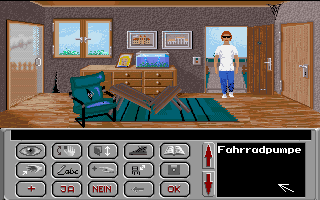Retro Replay Review
Gameplay
Das Erbe presents a classic point-and-click interface that’s both intuitive and nostalgic. You navigate your young protagonist through the dusty hallways and overgrown gardens of an old mansion, clicking on hotspots to examine objects, pick up tools, and solve puzzles. Each interaction yields a clue or a resource that brings you one step closer to a successful, eco-friendly renovation.
(HEY YOU!! We hope you enjoy! We try not to run ads. So basically, this is a very expensive hobby running this site. Please consider joining us for updates, forums, and more. Network w/ us to make some cash or friends while retro gaming, and you can win some free retro games for posting. Okay, carry on 👍)
The core challenge revolves around environmental constraints: you must remove old wiring, repair roofing materials, and clear debris without resorting to toxic chemicals or wasteful practices. This eco-themed puzzle design is layered—some solutions require combining items, while others prompt you to consult a list of green renovation guidelines. The reliance on logic and planning feels rewarding as you work through each room’s unique obstacle.
Puzzle difficulty ranges from straightforward fetch-and-use tasks to more complex, multi-stage challenges. There’s no hand-holding through hints or walkthroughs within the game itself, encouraging players to explore every nook and cranny. While modern adventures often overload you with tutorials, Das Erbe trusts your curiosity, making each “aha” moment deeply satisfying.
Graphics
Graphically, Das Erbe wears its 1991 roots on its sleeve. The hand-drawn backgrounds boast a charmingly simple, pixel-art aesthetic, with muted color palettes that evoke the neglected state of the inheritance mansion. Although today’s gamers might find the visuals dated, there’s an undeniable warmth to the lovingly rendered hallways, dusty portraits, and decaying conservatory.
Character sprites are small but expressive, conveying surprise, determination, or exasperation with minimal frames of animation. The electric flicker of a broken lamp or the creak of a rotting floorboard adds atmospheric detail. In an era before hardware-accelerated lighting, pockets of shadow and light are cleverly suggested through contrast and shading techniques.
While high-definition textures and 3D models are absent, the game’s environmental messaging shines through in the art direction. Green motifs—ivy creeping up walls, a solar panel blueprint tucked in a drawer—are subtly integrated into each scene. For players interested in environmental advocacy, these touches reinforce the game’s educational goals without feeling heavy-handed.
Story
The narrative thrust of Das Erbe is deceptively simple: your eccentric uncle has passed away, leaving you three million in cash and an imposing old mansion. The catch? You can only inherit the fortune if you renovate the house in an eco-responsible way. This premise hooks you immediately, balancing personal gain against moral responsibility.
Throughout your journey, brief journal entries and letters from your uncle provide backstory and guidance. You learn of his passion for sustainable living and his regrets about past renovation mistakes. These snippets enrich the main plot, transforming the mansion from a mere puzzle box into a living character with a history to uncover.
Interactions with non-player characters are limited but impactful. A neighbor might reveal local folklore about the house’s origins, while an environmental inspector clarifies the regulations you must follow. This sparse but well-placed dialogue deepens immersion and hints at a wider world beyond the mansion’s gates, without straying into superfluous side quests.
Overall Experience
Playing Das Erbe today feels like discovering a hidden time capsule of early 1990s educational gaming. The title’s blend of adventure-game tropes and environmental stewardship offers a unique experience that stands apart from modern blockbusters. It’s a short campaign—many players can finish it in just a few sessions—but each hour is packed with thoughtful puzzle design and eco-conscious messaging.
As an educational tool, Das Erbe excels. Its puzzles are firmly rooted in real-world renovation dilemmas, and the game never compromises on environmental realism. Whether you’re a teacher seeking interactive classroom material or a retro-game enthusiast craving a different kind of adventure, you’ll find value in its balanced approach to fun and awareness.
Because it’s freely distributed by the German environmental authorities, there’s virtually no barrier to entry. Simply download and play. While you shouldn’t expect cutting-edge graphics or voice acting, the core of Das Erbe—a well-crafted, eco-focused point-and-click adventure—remains engaging and relevant. If you appreciate thoughtful puzzles and a game that challenges you to think sustainably, Das Erbe is a small but rewarding inheritance well worth claiming.
 Retro Replay Retro Replay gaming reviews, news, emulation, geek stuff and more!
Retro Replay Retro Replay gaming reviews, news, emulation, geek stuff and more!









Reviews
There are no reviews yet.